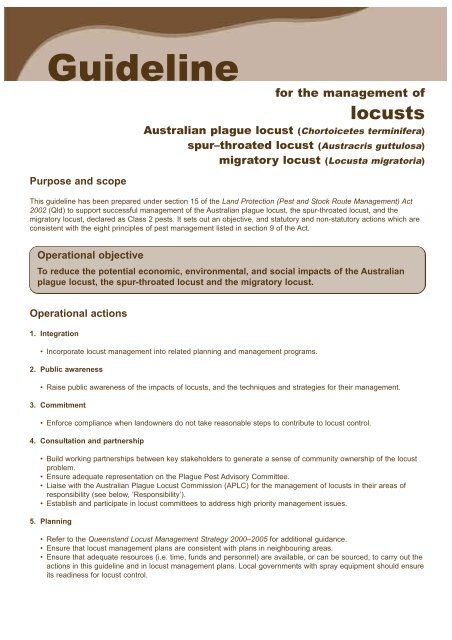Guideline for the management of locusts - Queensland Government
Guideline for the management of locusts - Queensland Government
Guideline for the management of locusts - Queensland Government
You also want an ePaper? Increase the reach of your titles
YUMPU automatically turns print PDFs into web optimized ePapers that Google loves.
<strong>Guideline</strong><br />
Purpose and scope<br />
<strong>for</strong> <strong>the</strong> <strong>management</strong> <strong>of</strong><br />
<strong>locusts</strong><br />
Australian plague locust (Chortoicetes terminifera)<br />
spur–throated locust (Austracris guttulosa)<br />
migratory locust (Locusta migratoria)<br />
This guideline has been prepared under section 15 <strong>of</strong> <strong>the</strong> Land Protection (Pest and Stock Route Management) Act<br />
2002 (Qld) to support successful <strong>management</strong> <strong>of</strong> <strong>the</strong> Australian plague locust, <strong>the</strong> spur-throated locust, and <strong>the</strong><br />
migratory locust, declared as Class 2 pests. It sets out an objective, and statutory and non-statutory actions which are<br />
consistent with <strong>the</strong> eight principles <strong>of</strong> pest <strong>management</strong> listed in section 9 <strong>of</strong> <strong>the</strong> Act.<br />
Operational objective<br />
To reduce <strong>the</strong> potential economic, environmental, and social impacts <strong>of</strong> <strong>the</strong> Australian<br />
plague locust, <strong>the</strong> spur-throated locust and <strong>the</strong> migratory locust.<br />
Operational actions<br />
1. Integration<br />
• Incorporate locust <strong>management</strong> into related planning and <strong>management</strong> programs.<br />
2. Public awareness<br />
• Raise public awareness <strong>of</strong> <strong>the</strong> impacts <strong>of</strong> <strong>locusts</strong>, and <strong>the</strong> techniques and strategies <strong>for</strong> <strong>the</strong>ir <strong>management</strong>.<br />
3. Commitment<br />
• En<strong>for</strong>ce compliance when landowners do not take reasonable steps to contribute to locust control.<br />
4. Consultation and partnership<br />
• Build working partnerships between key stakeholders to generate a sense <strong>of</strong> community ownership <strong>of</strong> <strong>the</strong> locust<br />
problem.<br />
• Ensure adequate representation on <strong>the</strong> Plague Pest Advisory Committee.<br />
• Liaise with <strong>the</strong> Australian Plague Locust Commission (APLC) <strong>for</strong> <strong>the</strong> <strong>management</strong> <strong>of</strong> <strong>locusts</strong> in <strong>the</strong>ir areas <strong>of</strong><br />
responsibility (see below, ‘Responsibility’).<br />
• Establish and participate in locust committees to address high priority <strong>management</strong> issues.<br />
5. Planning<br />
• Refer to <strong>the</strong> <strong>Queensland</strong> Locust Management Strategy 2000–2005 <strong>for</strong> additional guidance.<br />
• Ensure that locust <strong>management</strong> plans are consistent with plans in neighbouring areas.<br />
• Ensure that adequate resources (i.e. time, funds and personnel) are available, or can be sourced, to carry out <strong>the</strong><br />
actions in this guideline and in locust <strong>management</strong> plans. Local governments with spray equipment should ensure<br />
its readiness <strong>for</strong> locust control.
<strong>Guideline</strong><br />
6. Prevention<br />
• Implement coordinated preventative control <strong>of</strong> swarms and immature <strong>locusts</strong> in areas where <strong>the</strong>y threaten <br />
agriculture.<br />
• Monitor and predict locust activity.<br />
7. Best practice<br />
• Collate and distribute locust best practice in<strong>for</strong>mation to landholders.<br />
• Follow best practice in locust <strong>management</strong>.<br />
• Maintain contingency funding arrangements, and use <strong>the</strong> Plague Pest Contingency Fund in accordance with<br />
approved procedures.<br />
8. Improvement<br />
• Keep up-to-date with research on <strong>the</strong> <strong>management</strong> <strong>of</strong> <strong>locusts</strong>.<br />
Background<br />
Three species <strong>of</strong> locust have been declared <strong>for</strong> <strong>the</strong>ir capacity to rapidly build up in numbers, migrate, and severely<br />
affect parts <strong>of</strong> <strong>Queensland</strong>. The development <strong>of</strong> plagues depends on <strong>the</strong> amount, distribution, and timing <strong>of</strong> rainfall<br />
throughout <strong>Queensland</strong>. Certain combinations <strong>of</strong> <strong>the</strong>se factors can make significant plagues possible.<br />
The APLC accepts responsibility <strong>for</strong> any locust situation in <strong>Queensland</strong> that represents a threat to sou<strong>the</strong>rn states.<br />
Responsibility <strong>for</strong> locust <strong>management</strong> in areas outside <strong>the</strong> APLC’s area <strong>of</strong> responsibility is shared between landholders<br />
(<strong>for</strong> <strong>locusts</strong> that can be controlled within <strong>the</strong> resources <strong>of</strong> individual landholders), local governments (advice and<br />
coordination), and DEEDI (advice, coordination, and control <strong>of</strong> swarms). Local governments in crop production areas<br />
that are at risk currently make annual payments into a Plague Pest Contingency Fund. This fund has a ceiling <strong>of</strong><br />
$500 000 with a commitment <strong>of</strong> matching funding from <strong>the</strong> <strong>Queensland</strong> <strong>Government</strong> <strong>of</strong> up to $250 000 in any financial<br />
year, and is used to fund control activities.<br />
Control <strong>of</strong> <strong>locusts</strong> must take into consideration <strong>the</strong> economic, practical, and technical feasibility <strong>of</strong> control methods.<br />
Reactive control is expensive and largely unproductive, whereas preventative control based on monitoring, prediction,<br />
and strategic chemical or myco-insecticide (Metarhizium) applications are effective and economically feasible.<br />
Responsibility<br />
Landowners: localised control <strong>of</strong> <strong>locusts</strong>; in-crop control <strong>of</strong> <strong>locusts</strong><br />
Local governments: control <strong>of</strong> <strong>locusts</strong> in places such as roadsides and reserves.<br />
DEEDI, Australian Plague Locust Commission (in defined areas): broad-scale strategic and preventative locust <br />
control.<br />
Environmental Protection Agency (EPA): locust control, and monitoring any adverse effects <strong>of</strong> control, on EPA<br />
estates.<br />
DEEDI, local governments, Australian Plague Locust Commission (in defined areas): surveillance and mapping.
<strong>Guideline</strong><br />
References<br />
Biological control: locust <strong>management</strong> in <strong>Queensland</strong>, (report <strong>of</strong> research into <strong>the</strong> use <strong>of</strong> Metarhizium to manage<br />
<strong>locusts</strong> in <strong>Queensland</strong>), available at www.dpi.qld.gov.au<br />
Identification <strong>of</strong> <strong>locusts</strong> fact sheet available at www.dpi.qld.gov.au<br />
<strong>Queensland</strong> Locust Management Strategy 2000–2005 available at www.dpi.qld.gov.au<br />
Locusts in <strong>Queensland</strong>, Pest risk assessment available at www.dpi.qld.gov.au<br />
Date <strong>of</strong> approval: February 2004

















